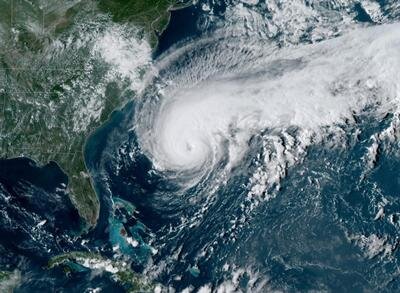New research shows that hurricane maximum wind speeds in the subtropical Atlantic around Bermuda have more than doubled on average over the last 60 years due to rising ocean temperatures in the region.
Hurricanes intensify by extracting energy from the warm ocean surface via air-sea heat fluxes, so a warmer ocean can lead to more intense hurricanes.
Improving predictions of wind speeds from hurricanes will help determine the right level of response in advance of the storm and potentially limit the resulting damage in Bermuda.
Between 1955 and 2019 mean hurricane intensity near Bermuda, measured by the maximum wind speed, increased from 35 to 73mph — equivalent to over 6mph per decade. At the same time sea surface and sub surface temperatures in the region increase by upto 1.1°C, providing the additional energy for hurricanes to intensify.
The study, published in Environmental Research Letters, also develops a predictor for the intensity of hurricanes moving through the Bermuda area using the average upper ocean temperature in the top 50m layer.
Find your dream job in the space industry. Check our Space Job Board »
Samantha Hallam, the lead author of this paper from the University of Southampton and the National Oceanography Centre (NOC), said , “The approach we used could provide a better way to predict Bermuda storm intensity than current theory or operational methods alone. It could also be use elsewhere in the subtropical Atlantic where there is a shallow mixed layer depth, typically north of twenty five degrees north.
“We used hurricane potential intensity theory, locally-based weather balloon soundings, surface and upper ocean observations of conditions in and around hurricanes passing within 100km of Bermuda over the last 65 years (including direct hits and ‘near-miss’ storms).”
Mark Guishard, co-author and Director of the Bermuda Weather Service said “the research demonstrates the greater relevance of upper ocean heat versus sea surface temperatures alone in the prediction of hurricane intensity. Preliminary testing with the recent passage of Hurricane Paulette shows promising results that this technique could be further developed into an additional operational tool for forecasters locally.”
These findings are the result of a statistical analysis on hurricane paths within 100km of Bermuda, between 1955 and 2019. The research used surface and subsurface ocean temperature observations from the Bermuda Atlantic Times Series (BATS) Hydrostation S programme, managed by the Bermuda Institute of Ocean Sciences.
This research was funded by the Natural Environmental Research Council (NERC) and Bermuda Institute of Ocean Sciences, and involved a collaboration between the University of Southampton, the National Oceanography Centre, the Bermuda Institute of Ocean Sciences and the Met Office.
Provided by: University of Southampton
More information: Samantha Hallam et al. Increasing tropical cyclone intensity and potential intensity in the subtropical Atlantic around Bermuda from an ocean heat content perspective 1955- 2019. Environmental Research Letters (2021). DOI: 10.1088/1748-9326/abe493
Image: Satellite image of Hurricane Humberto, west of Bermuda, Sept 2019. Credit: NOAA











